Google App Engine + JSF 2 Example
In this tutorial, we will show you how to develop and deploy a JSF 2.0 web application in Google App Engine (GAE) environment.
Tools and technologies used :
- JDK 1.6
- Eclipse 3.7 + Google Plugin for Eclipse
- Google App Engine Java SDK 1.6.3.1
- JSF 2.1.7
Note
This example is going to reuse this JSF 2.0 hello world example, modify it and merge it with this GAE + Java example.
This example is going to reuse this JSF 2.0 hello world example, modify it and merge it with this GAE + Java example.
1. New Web Application Project
In Eclipse, create a new Web Application project, named as “JSFGoogleAppEngine“.
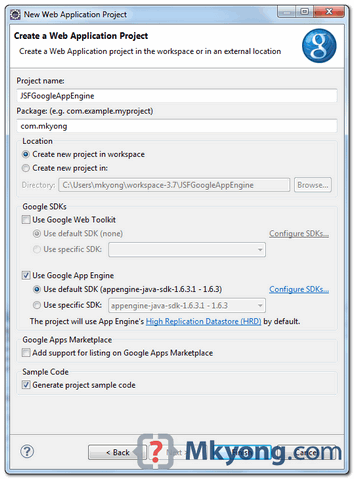
“Google Plugin for Eclipse” will generate a sample of GAE project structure.
2. JSF 2 Dependencies
To use JSF 2 in GAE, you need following jars
- jsf-api-2.1.7.jar
- jsf-impl-2.1.7.jar
- el-ri-1.0.jar
Copy and put it in “war/WEB-INF/lib” folder.
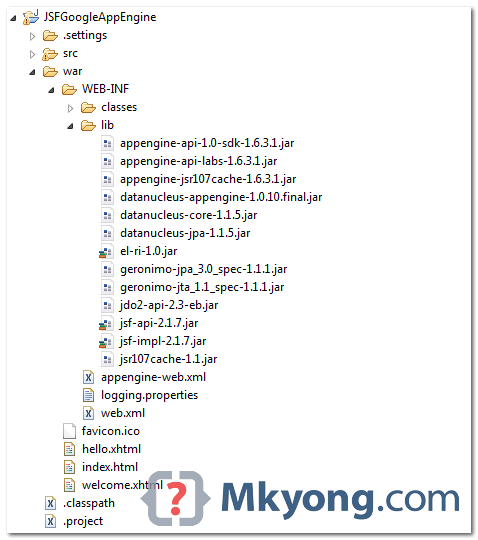
Right click on project folder, select “Properties“. Select “Java Build Path” -> “Libraries” tab, click “Add Jars” button and select above jars.
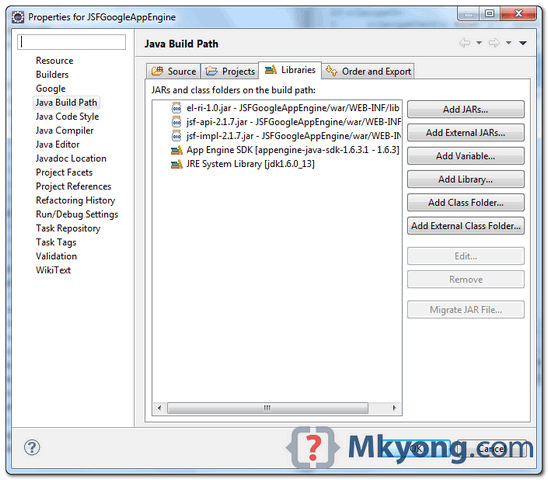
Note
You need to put this
You need to put this
el-ri-1.0.jar, otherwise, you will hit error message – Unable to instantiate ExpressionFactory ‘com.sun.el.ExpressionFactoryImpl’.3. JSF Managed bean
3.1 Delete plugin generated
JSFGoogleAppEngineServlet.java, you don’t need this.
3.2 Create a managed bean.
File : src/com/mkyong/HelloBean.java
package com.mkyong; import javax.faces.bean.ManagedBean; import javax.faces.bean.SessionScoped; import java.io.Serializable; @ManagedBean @SessionScoped public class HelloBean implements Serializable { private static final long serialVersionUID = 1L; private String name; public String getName() { return name; } public void setName(String name) { this.name = name; } }
3.3 Create a new WebConfiguration.java.
JSF 2 is using “
javax.naming.InitialContext” that’s not support in GAE.
To solve this, you need to get a copy of the JSF’s source code, clone the
WebConfiguration.java, comment methods that are using “javax.naming.InitialContext” class, put it in “src/com/sun/faces/comfig/WebConfiguration.java“. Now, your newly created WebConfiguration.java class will overload the original WebConfiguration.java.
Note
Get the full source code of the WebConfiguration.java.
Get the full source code of the WebConfiguration.java.
I don’t think GAE team will white-list this jar, just hope JSF’s team can fix this in future release.
4. JSF Pages
4.1 Create
hello.xhtml page, accept a user input and pass it to helloBean.
File : war/hello.xhtml
version="1.0" encoding="UTF-8"?>
4.2 Create
welcome.xhtml page, display the user input from hellobean.
File : war/welcome.xhtml
version="1.0" encoding="UTF-8"?>
4.3 Delete the plugin generated
index.html file, you don’t need this.5. web.xml
Update web.xml, integrate JSF 2.
File : web.xml
version="1.0" encoding="utf-8"?>
xmlns:xsi="http://www.w3.org/2001/XMLSchema-instance"
xmlns="http://java.sun.com/xml/ns/javaee"
xmlns:web="http://java.sun.com/xml/ns/javaee/web-app_2_5.xsd"
xsi:schemaLocation="http://java.sun.com/xml/ns/javaee
http://java.sun.com/xml/ns/javaee/web-app_2_5.xsd"
version="2.5">
Note
GAE do not support server side state management, so, you need to define “
GAE do not support server side state management, so, you need to define “
javax.faces.STATE_SAVING_METHOD” to “client“, to avoid of this “View /hello.xhtml could not be restored” error message in GAE production environment.6. Enable Session in GAE
Update
File : appengine-web.xml
appengine-web.xml, enable session support, JSF need this.File : appengine-web.xml
version="1.0" encoding="utf-8"?>
xmlns="http://appengine.google.com/ns/1.0">
7. Directory Structure
Review final directory structure.
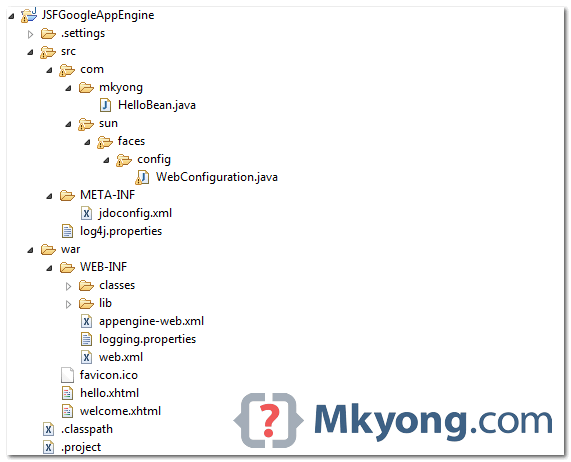
8. Run on Local
Right click on the project, run as “Web Application”.
URL : http://localhost:8888/hello.jsf
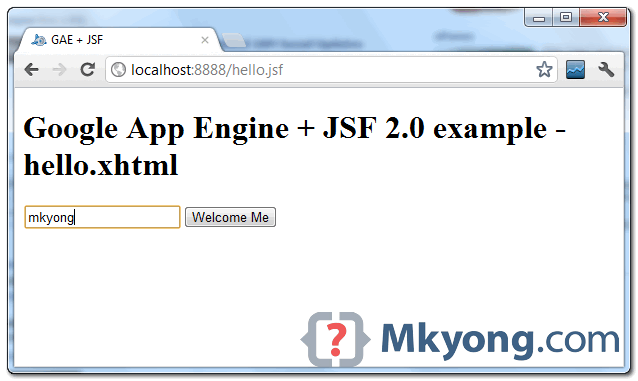
Click on the button.
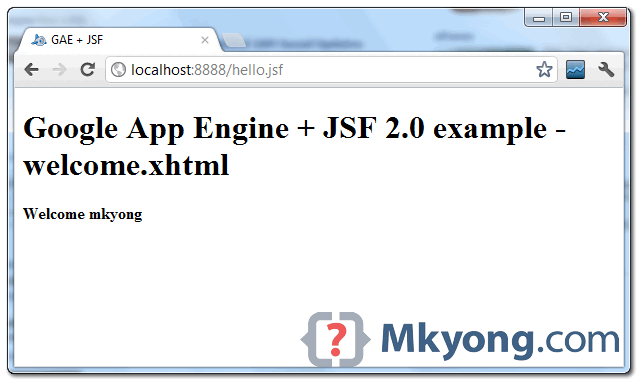
10. Deploy on GAE
Update
appengine-web.xml file, add your App Engine application ID.
File : appengine-web.xml
version="1.0" encoding="utf-8"?>
xmlns="http://appengine.google.com/ns/1.0">
Select project, click on Google icon, “Deploy to App Engine“.
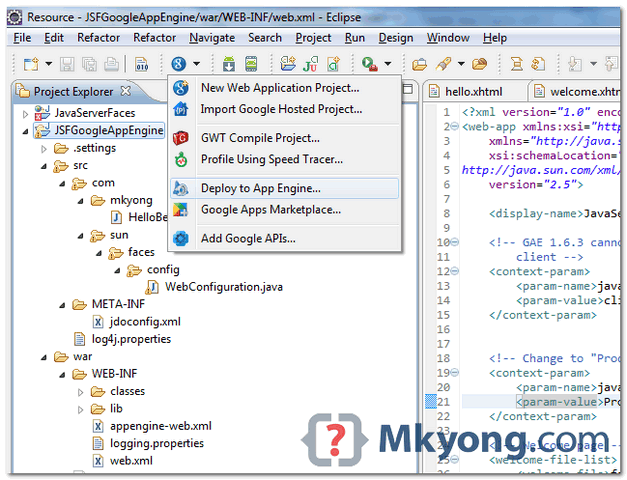
URL : http://mkyong-jsf2gae.appspot.com/hello.jsf
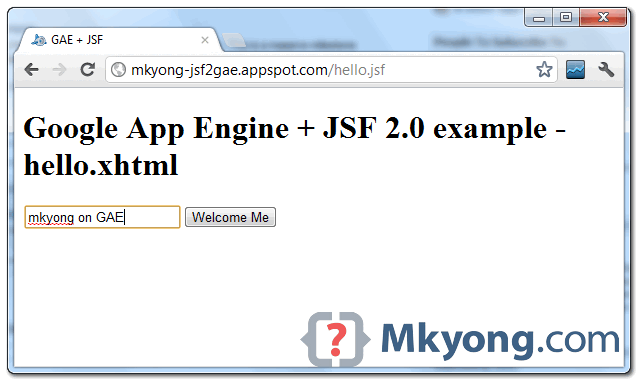
Download Source Code
Due to large file size, all JSF and GAE jars are excluded.
Download – JSF2-GoogleAppEngine-Example.zip (42 KB)
yeezy boost 350
ReplyDeletemichael kors purses
vans shoes
retro jordans
christian louboutin shoes
supreme new york
golden goose sneakers
nike air max 270
michael kors outlet
off white jordan 1